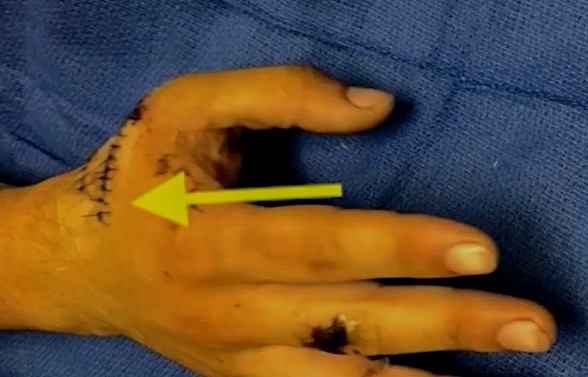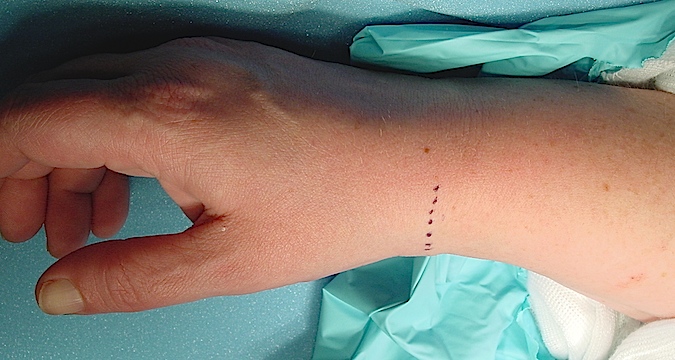Abductor Pollicis Longus (APL) Exam
Origin: Middle third of the posterior surfaces of the ulna and radius, and the interosseous membrane.
Insertion: Base of the first metacarpal bone of the thumb.
Innervation: Posterior interosseous nerve.
Nerve: Radial nerve (via posterior interosseous nerve branch)
APL Muscle Testing
When assessing a thumb injury for signs of abductor pollicis longus (APL) laceration, the goal is to determine whether the APL tendon is completely lacerated, partially transected, or intact. In the examination of an uninjured APL musculotendinous unit, the 0 to 5 muscle testing grading system is applied. In this system, zero indicates a total loss of abductor pollicis longus (APL) contraction, while a grade of 5 represents normal APL function capable of contracting against standard resistance. Detailed information on graded muscle testing is provided below. Typically, full muscle testing is impractical in cases of acute laceration due to pain and tenderness. The examiner may have to rely on the observation that the laceration occurred in the dorsal section containing the APL. Nevertheless, the examiner should assess the contraction of the potentially injured musculotendinous unit as comprehensively as possible. The examination's primary aim is to preoperatively determine whether the tendon is completely, partially cut, or intact. To evaluate the APL, position the patient's hand and upper extremity with the forearm in mid-rotation and the wrist in a neutral position, with the ulnar side of the hand resting on the table. The thumb should be in a flexed or resting posture. Alternatively, place the patient’s forearm in pronation with the wrist in neutral and the thumb in a relaxed position as a starting point.
The examiner then supports the ulnar side of the patient's hand using the table. Next, the examiner applies pressure with their other hand to the dorsal radial surface of the distal metacarpal of the thumb to gently resist the patient's attempt to actively abduct the thumb. The examiner instructs the patient to "move your thumb away from your palm and hold it. Don't let me push it back." The resistance to abduction will vary based on the degree of injury to the APL and on the discomfort caused by the exam.
Definition of Positive Result in APL Muscle Testing: A normal result is a positive one. During a normal muscle test, the examiner should observe a normal muscle contraction that can move the joint or tendon against full resistance.
Definition of Negative Result in APL Muscle Testing: The APL tendon slips should be observed and palpated and compared to the uninjured side. In muscle testing, an abnormal result is a negative one. During a partially abnormal muscle test, the examiner should observe an abnormal muscle contraction that can move the joint or a tendon but not against normal resistance. In a complete denervation injury, such as a complete radial nerve palsy, there will be no evidence of any muscle contraction, and the muscle testing grade will be zero.
In a patient with a laceration of the APL at the thumb's carpometacarpal (CMC) joint area, the joint may not actively abduct at all due to a complete transection (cut) of the APL tendon. This results in an abnormal or negative muscle testing or possibly a grade 3 due to muscle belly contraction without active thumb CMC joint abduction. However, these observations also indicate a complete APL laceration requiring surgical repair. Thus, this negative muscle testing exam will be positive for a complete APL laceration.
- Abductor Pollicis Longus (APL) tendon slips pass through the first extensor compartment of the wrist before inserting into the base of the thumb metacarpal.
- In the first extensor compartment the Abductor Pollicis Longus (APL) can have from 1 to 7 separate slips.
- The Abductor Pollicis Longus (APL) slips are volar and ulnar to the EPB tendon in the first extensor compartment.



